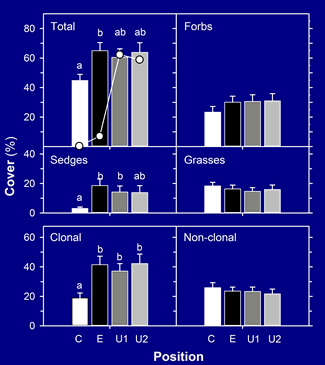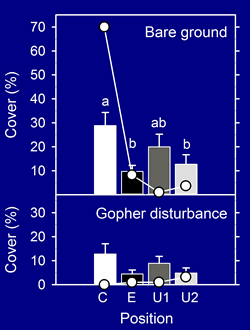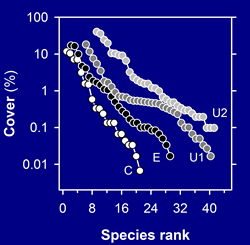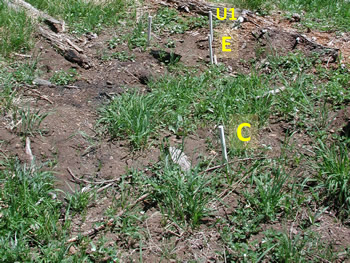Disturbance. Cover of bare ground remained elevated at the centers, but not edges, of scars (see ground cover graph, right). However, much of this was due to gopher burrowing (see photo, below).
Vegetation. Vegetation was dominated by native meadow species; exotics were rare. Total cover was comparable in and adjacent to scars (see cover graphs, below). Although cover of grass and non-clonal species was comparable in and adjacent to scars, cover of forb, sedge, and clonal species was reduced in the centers.
Richness remained depressed in the centers of scars (see richness graphs, below). Compared to the unburned vegetation, scar centers had many fewer, but more dominant species (see rank abundance curves, right). These included species with prolific seed production (Bromus carinatus, Elymus glaucus, and Cirsium callilepis), effective wind dispersal (Cirsium callilepis), and rapid stoloniferous growth (Fragaria spp.).
| Plant cover |
 |
| Mean cover (+1 SE, n = 30) of growth forms and of clonal vs. non-clonal species in year 7. Circles are first-year values. Different lower case letters indicate significant differences among positions. |
|
|
| Richness |
 |
| Mean richness (+1 SE, n = 30) of growth forms and of clonal vs. non-clonal species in year 7. Circles are first-year values. Different lower case letters indicate significant differences among positions. Sedge richness is not shown (mostly Carex pensylvanica). |
|
|
|
| Ground cover |
 |
| Mean cover (+1 SE, n = 30) of bare ground and recent gopher disturbance in year 7. Circles are first-year values. Different lower case letters indicate significant differences among positions. |
|
|
| Rank-abundance curves |
 |
Rank-abundance curves illustrating the distribution of mean cover of species
(n = 30). |
|
|
Halpern, C. B., J. A. Antos, and L. M. Beckman. 2014. Vegetation recovery in slash-pile scars following conifer removal in a grassland restoration experiment. Restoration Ecology 22:731-740. Request reprint |
|
| Conclusions |
We saw little evidence of long-term physical scarring from pile burning. After 7 yr, cover of bare ground was only slightly elevated in the centers of scars—much of this attributable to gopher disturbance—and total plant cover, dominated by native meadow species, was comparable to the unburned vegetation.
Reduced richness at the centers of scars reflected poorer recovery of rhizomatous species, including the principal meadow sedge, Carex pensylvanica (or C. inops). Rank-abundance curves underscore this result: although scar centers regained cover, they were dominated by a small number of species with prolific seed production or vigorous stoloniferous growth.
Although scar centers developed a simpler community structure, they remained free of exotics and healed quickly, aided by the soil-disturbing activities of gophers. In the absence of exotics and in the presence of gophers, pile-burning appears to be a viable and efficient approach to fuel reduction. |
Gopher disturbance |

| Example of gopher mounding in and adjacent to a burn scar. Rapid immigration of gophers into the restoration plots results in substantial mixing of fire-affected soils. |
|
|
![]()
![]()
![]()
![]()




